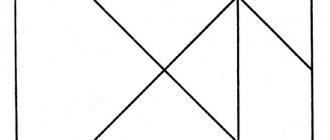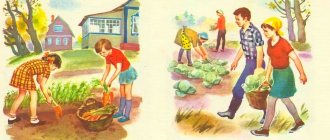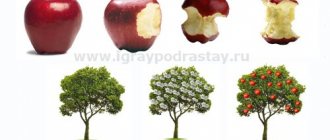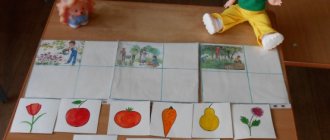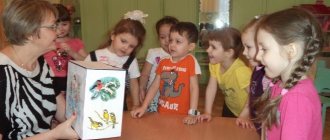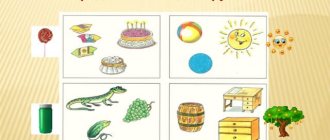Maria Malakhova
Didactic game
"
Vegetable garden "
.
For children of primary preschool age. Goal: - learn to determine the spatial arrangement of objects; clarify children’s knowledge about vegetables, where they grow, and their benefits to humans;
Learn to distinguish vegetables by appearance, describe them by their characteristic features;
Learn to use the general concept “Vegetables”
, enrich vocabulary by denoting qualities;
Develop attention, memory, perseverance, coordination of movements, fine motor skills of the hands.
Progress of the game: Children are given fruits and vegetables. They must distribute where the fruits grow and where the vegetables grow. While completing the task, children consolidate the names of vegetables.
Didactic game "Vegetable garden"
Naida Safarbekova
Didactic game "Vegetable Garden"
Didactic game "
Vegetable Garden " Didactic game " Vegetable Garden "
Didactic game " Vegetable garden "
intended for preschool children in classes on cognitive development, the formation of primary ideas about the objects of the surrounding world. Thanks to this manual, speech, thinking, imagination develops, and fine motor skills of the fingers develop.
Objectives: To consolidate children's knowledge about vegetables and where they grow. Learn to distinguish vegetables by appearance. Enrich children's vocabulary.
Material: To create a didactic game “ Vegetable Garden ”
Felt of different colors, cotton wool or synthetic padding were used. To create beds, you can use old brown or black tights, you can also use knitted fabric. The beds can be placed in a pre-pasted box or in a box. Next, we plant vegetables in the beds.
The teacher asks the child to collect the harvest; while harvesting, the child names the vegetable, thereby reinforcing the names of the vegetables.
The teacher asks another child to plant vegetables of certain colors in the garden. For example: the teacher suggests planting an orange vegetable, The child plants carrots.
game also help the child to consolidate the count: one cabbage, three carrots, two beets, etc.
Didactic game for children with disabilities “Nakhodilki”. Game from a hardware store Didactic game for children with disabilities "Nakhodilki" Game from a hardware store, because the idea for this game appeared while visiting the store. Didactic game “Our Garden” For the full development of young preschoolers, various didactic games are very important and significant. What could be better than a game? Didactic game "Vegetable Garden" Goal. Learn to name and distinguish bushes, fruits, vegetable seeds by description, appearance, method of cultivation; develop fine motor skills. Didactic game “Vegetable Garden” Don’t rush to throw away egg cartons! A minimal set of tools, a little time and a desire to create can transform unsightly trays. Didactic game "Vegetable Garden" The didactic game "Vegetable Garden" can be used in games with children of primary preschool age to familiarize themselves with the world around them and develop. A didactic game to introduce children to folk arts and crafts. Didactic game “Make a Pattern” The art program in kindergarten provides the following tasks for decorative drawing: learn to draw based on Russian embroidery.
Presentation “Didactic game “Healthy and healthy game” The didactic game “Healthy and healthy game” is a presentation containing fourteen questions about proper nutrition. Questions.
Presentation “Multimedia didactic game “Miracle Garden” One of the main tasks of preschool institutions in the context of the transition to a new quality of education is to ensure individualization.
Knitted educational game “Vegetable Garden” The game consists of a knitted bed and knitted vegetables, as well as laminated pictures of vegetables. This is what a mini-garden with beds looks like...
Source
Didactic game “What grows in the garden?”
Tatyana Alshevskaya
Didactic game “What grows in the garden?”
Material: cards with images of vegetables, fruits, mushrooms, berries, items of non-plant origin (toys, clothes, etc.)
;
board on which stripes are glued - beds .
Option 1: “What are we talking about?”
. The teacher asks riddles, and the children find a card with the desired answer.
1) Offer children cards with vegetables (fruits, mushrooms, berries, among which there will be one extra item (for example, not a vegetable)
.
2) Offer children cards with objects of the same color (shapes, among which there will be an object of a different color (shapes)
. Ask him to explain why he is superfluous.
3) From all items, remove the one that does not grow in its region (for example, pineapple)
.
4) Remove from all items the one that is not a plant .
Option 3: “Where does it grow ?”
.
1) Select only those items that grow in the garden bed .
2) Select only those items that grow in our region .
Option 4: “Find out by description”
. The teacher describes the object (vegetable, fruit, mushroom, berry; children use the description to find the object.
Expanding children’s knowledge about the world around them “What grows in the garden” Goal: expanding children’s knowledge about the world around them, about nature. Educational objectives: To consolidate children's knowledge about autumn signs.
Project “What a miracle vegetable garden is growing in the window” How vegetables would not be born without our help. As soon as spring has arrived, we plant seeds. What a garden! People are surprised. The sun warmed the earth. Didactic game “What is good and what is bad for teeth?” Objectives: to introduce children to the concepts of “health” and “disease”, “healthy” and “harmful” foods; develop the ability to take care of your health. Didactic game “What is good and what is bad for health” Purpose of the game: to introduce children to the rules of personal hygiene and a correct, careful attitude towards their health; find out what is useful and what is not. Didactic game “Who lives where, what grows where?” Dear colleagues! Good day everyone! In my work on environmental education of preschoolers, I attach great importance. Didactic game “Harvest in the garden - collect and plant” Didactic game “Harvest in the garden - collect and plant” The game is designed for children of the younger group (from 2 to 4 years old) Purpose: to develop cognitive skills.
Summary of educational activities for the younger group “What grows in the garden bed” St. Petersburg State Budgetary Institution “CHILDREN'S SANATORIUM “KOSTYOR” Summary of educational activities for children of the 5th group “What grows in the garden bed” Educator: T. A. Novozhilova.
Mini-museum “What grows in the garden bed” As part of the implementation of the long-term project “Myselskie Residents”, on November 19, a mini-museum “What grows in the garden bed” was opened in the kindergarten.
Presentation “What grows in our garden” Presentation “What grows in our garden”. The presentation is presented in the form of a game of Masha and the Bear. Once upon a time there lived Masha and the Bear in a house, but...
Lesson “What grows in the garden” (middle group) Purpose: to systematize and generalize children’s ideas about vegetables that differ from each other in appearance. Integration of educational.
Source
Game-competition “Gifts of Autumn” on the topic: “Vegetables and fruits”
Gomzyakova Irina Nikolaevna Bogatyreva Elena Veniaminovna teachers MBDOU "Kindergarten of a combined type "Teremok" Borisovka village, Belgorod region
The material was sent for publication in the All-Russian printed collection of practice-oriented materials “Preschool and primary education - modern methods and technologies of teaching and upbringing” - SEPTEMBER 2022.
COMPETITION GAME “GIFTS OF AUTUMN” ON THE TOPIC: “VEGETABLES AND FRUITS”
Goal : Generalization and systematization of children’s knowledge about vegetables and fruits.
Advertising message
General education : to develop children’s knowledge about fruits and vegetables, to consolidate the general concepts of “vegetables” and “fruits”;
Developmental : develop attention, imagination, creative thinking, creativity, activate the child’s vocabulary, introduce a new word “TASTE”, develop the ability to solve riddles, select the right word, answer questions;
Educational : cultivate the ability to listen and respect the opinions of your comrades, contribute to the formation of a children's team.
Preliminary work:
- Learning the poem “Gifts of Autumn.”
- Guessing riddles.
- Making crafts from natural materials.
Materials for the lesson:
cut-out pictures for each table on the topic: vegetables, fruits; 2 scarves; diplomas; cups with pieces of fruits and vegetables; aprons, pots and ladles; colour pencils; a bag of vegetables and fruits; 2 cars and baskets; bumps.
Event plan:
- Introductory speech by the presenter (poem, distribution into teams, introduction to the rules of the game...)
- Competition stages:
- School for the Curious
- Vegetables and fruits
- Harvest the harvest
- Tops and roots
- Fun coloring book
- Magic bag
- Transport the harvest
- Cooks
- Taster
- Summing up the results of the game, rewarding.
Progress of the event:
- - Dear Guys! Now I’ll tell you a riddle, and you try to guess it:
“I came without paints and without a brush. And repainted all the leaves.” – What do you think this riddle is about? (about autumn)
- That's right, guys. Today we all gathered here not by chance, but to talk about this interesting time of year - about autumn.
– What is autumn like? Describe it (beautiful, sad, rainy, cold...). – And she’s also generous! After all, she does not come to us empty-handed... - What do we collect in the fall? (harvest). - What is the harvest? (vegetables, fruits, mushrooms, nuts)
- Guys, our girls have prepared a poem for you called “Gifts of Autumn.” Listen to him.
1 child: Hello, Autumn! How are you? What did you bring as a gift? – I brought you vegetables, just a treat. Rich in vitamins My treat for you!
2nd child: If you go into the garden, you will find vegetables there. There are potatoes and tomatoes, pepper, cucumber, salad. If you find yourself in the forest, you will find mushrooms and berries!
3rd child: Take the baskets, collect my gifts! If you go to the garden - wow! I brought you fruits - Pears, apples and melons, I don’t know their taste more wonderful.
- Well done, girls! Guys, what is this poem about? (about fruits and vegetables) -Where do fruits grow? (in the garden) -Where do vegetables grow? (in the garden) - I see that you know a lot about autumn, about fruits and vegetables.
Guys! I propose today to arrange a game-competition and find out who knows more about vegetables and fruits. To do this we need to split into 2 teams.
(Children take turns taking out dummies of vegetables or fruits from a wonderful bag).
– We will now guess what you name your teams:
– Shine on the satin skin. Stop! There is a traffic light in the garden! It shines bright red Juicy ripe... (tomato).
The first team will be called "Tomato".
– We have teams, but who will evaluate us? Who will decide the winning team? (Jury!)
– We present to you our strict jury.
– Now let’s remember the rules of the game:
- Questions are asked to the teams in turn.
- Don't interrupt each other.
- Don't give any hints.
- For each correct answer, the Tomato team receives a vegetable, and the Orange team receives a fruit.
At the end of the game, the jury will count your fruits and vegetables. The team with the most vegetables or fruits will win. Is everyone clear? (Yes!)
– Are the teams ready to play? (Yes!) – Is the jury ready to evaluate us? (Yes!) Let's start playing!
- – The first stage of the game is called “School for the Curious.” I will ask one riddle to each team in turn. Only the team I contact responds. The rest are silent. If a team does not give the correct answer, then the right to answer passes to the next team...:
- Girlfriends live in a green hut. Like beads are round, emerald and small. (peas)
- Yellow, juicy honey fruit grows on a garden tree. (pear)
- Yellow Antoshka Spins on his leg. Where the sun stands, That's where he looks. (sunflower)
4.It is green, round, smooth. And inside it is red and sweet. (watermelon)
- Although it tastes bitter, But inside it is white and strong. And on a grater it is given to those who are sick. (radish)
- Just like a fist. Red barrel, If you touch it, it’s smooth, but if you bite it, it’s sweet (apple).
- An old grandfather is sitting, dressed in a golden fur coat. Whoever undresses him sheds tears. (onion)
- Believe it or not, we come from America. In the fairy tale we are seniors, in the garden... (tomatoes)
- I looked at the sun, became prettier and rounder. I’m not used to the cold, I’m not cabbage, but... (pumpkin)
- It’s not at all difficult to guess, anyone can guess! The leaf is elastic, emerald green and curls into the head. (cabbage)
- I am growing in the ground in a garden bed, red, long, sweet. (carrot)
- It’s unsightly, a little bumpy, but when it comes to the table, the guys will say cheerfully: “Oh, it’s crumbly, it’s delicious!” (potato)
– The second stage of the game “Vegetables and Fruits”. Each team receives cards, which they must quickly and correctly sort into two groups: vegetables and fruits. Collected - raised your hand so that we can see that you have completed the task. The team that collects it first and correctly will receive a vegetable or fruit. It's clear? (Yes!) Let's get started!
– Third competition “Gather the Harvest” . At the leader's command, you must collect as many cones as possible in one minute and put them in your container. The team that collects the most cones will win. But we collect only with our elbows, like this... It's clear? (Yes!) Let's get started!
Now let’s play the attentive game “Tops and Roots.” We will call the edible root of the vegetable roots, and the edible fruit on the stem - tops. I will name a vegetable and if it has an edible root, then you will sit down. And if the top is edible, then raise your hands up.
Carrots (roots), tomatoes (tops), onions (tops and roots) Potatoes (roots), cucumber (tops), beets (roots), parsley (tops), garlic (roots), peas (tops), pepper (tops) .
– The next stage is “Fun Coloring”. Teams receive 4 pictures. The task is to quickly and correctly color the offered vegetable, fruit, berry and mushroom on command. Is the task clear? (Yes!) Let's start!
Physical education minute.
Now let's do a little work in the garden. We got up and did everything together, in unison.
We dug up potatoes, picked cucumbers from the garden, (squats) pulled out all the carrots, (bent over) deftly cut the cabbage. And they brought you a gift in a basket from the earth. Let's continue our game.
– And for this competition ( “Magic Bag” ), volunteers from each team come to me, one from each team.
- Now I blindfold them. Assignment - I approach everyone in turn, they take out one item from my bag, feel it and name it. For each correct answer - a point. It's clear?
- Have you stayed too long, guys? I suggest you move a little, run... We move on to the “Transport the crop” stage. The teams line up behind the line. The task is to put one vegetable or fruit into your car on command, drive the car to the warehouse - basket, unload it and return empty to the team, passing the baton to the next participant, and so on until all the vegetables and fruits are in the warehouse... Is the task clear? (Yes!) Let's get started!
Competition "Cooks"
– And now you will turn into imaginary chefs and cook.
– Team “Orange”, what can you make from apples? (compote, jam, apple pies, salad)
Team “Tomato”, what can you cook from cabbage? (cabbage soup, stewed cabbage, cabbage salad, sauerkraut, cabbage pies, cabbage rolls, schnitzel, dumplings).
– This competition involves one cook at a time. On command, the cooks put on an apron, move the pan inside them, select the products they need, put them in the pan and lift the ladle up, showing us that the task has been completed. And they tell you what they have prepared. It's clear?
– This competition is called “Taster”. Who knows what this word means? Who do we call a taster?
– A taster is a person who can easily identify any object or substance by smell. For example: at a factory that produces perfume, a taster tastes - smells a new perfume and gives it a beautiful name based on its smell.
– Let’s all say the word taster together and remember what it means...
– For this competition, volunteers from each team come to me, one from each team...
- Now I blindfold them. Assignment - I approach each person in turn and offer to identify the product that is on the plate by smell. A token is given for the correct answer. It's clear? (Yes!) Let's get started!
- Our game has come to an end. And now the jury will sum up the results, count your fruits and vegetables and announce the winners...
- While the jury is counting, I suggest you play: if I name a vegetable. Then you stomp your feet, and if it’s fruit, you clap your hands. Let's get ready. Let's start!
– The floor is given to our jury.
Bibliography:
- Poems about autumn – https://www.stihomaniya.ru/2017/07/stixi-pro-dary-oseni.html
- T.A. Shorygina “Vegetables. What are they?”, Moscow, “Gnome and D”, 2007, p.83-84
- “Wonderful Box” (Russian folk songs, fairy tales, games, riddles), Moscow, “Children’s Literature”, 1988.
You can see the table of authors and learn more about the collections HERE
Didactic game "Vegetable garden"
Maria Malakhova
Didactic game “Garden”
Didactic game " Vegetable garden "
. For children of primary preschool age.
- learn to distinguish vegetables by appearance, describe them by their characteristic features;
— learn to use the general concept “Vegetables”
, enrich vocabulary by denoting qualities;
- develop attention, memory, perseverance, coordination of movements, fine motor skills of the hands.
Progress of the game: Children are given fruits and vegetables. They must distribute where the fruits grow and where the vegetables grow. While completing the task, children consolidate the names of vegetables.
On the topic: methodological developments, presentations and notes
The main functions of a didactic game. A didactic game is a multifaceted, complex pedagogical phenomenon: it is both a game method of teaching preschool children and advanced.
The purpose and objectives of the musical game, Important aspects, Groups, forms of games.
An article for parents on musical education of preschool children.
Goal: to consolidate children’s knowledge about vegetables, clarify their name, color, shape, teach them to distinguish by appearance; expand the understanding of growing vegetable crops; develop observation and lu.
Expand your understanding of growing vegetables.
Expand your understanding of growing vegetables.
Source
Progress of the game: A garden is drawn on one album sheet, a vegetable garden on the other.
Nearby lie vegetables and fruits cut out of paper and colored with colored pencil.
Children distribute vegetables and fruits where they grow.
"Garden". Didactic game for preschool children Preschool children love to play with small toys. Therefore, they like to “plant” knitted vegetables in beds and knitted fruits. Didactic game for children 3–4 years old. Layout “Wild and domestic animals. Forest, garden, vegetable garden" Didactic game made by yourself. To create this game, I made a layout on which I depicted a forest on one side and a forest on the other. Didactic game “My Village” The game is made from an ordinary box covered with thick green fabric. A house is made from planks and glue. Decorative elements are used. Didactic game "Vegetable Garden" for children of primary preschool age Games with food have always been interesting to children as such. Role-playing games in the “shop”, “vegetable garden”, “kitchen” are simply irreplaceable for girls. Didactic board and printed game for children 4–5 years of age “Gifts from Burenka” DIDACTIC GAME “GIFTS FROM BURENKA!” Printed board game for children 4-5 years old TYPE OF GAME Cognitive orientation. Game with clothespins “Fun Garden” When working with children to develop fine motor skills, teach dialogical speech, and sensory education, you can use the following substitute items.
Summary of GCD for speech development. Didactic game for pronunciation of sounds [M]-[M'], [B]-[B']. Didactic game “Who left?” Goal: development of the articulatory apparatus. Objectives: 1. To develop the ability to clearly pronounce the sounds mm, b-b in sound combinations, to distinguish.
Educational game “Vegetable Garden” for children 3–4 years old Dear colleagues! In the nature center I placed a game for children of the second junior group “Vegetable Garden”, in the form of a model of a vegetable garden. The beds are made of centipon.
Abstract of the educational activity “Trip to the spring garden” of the workshop “Garden and Vegetable Garden” with children of the first junior group. Abstract of the educational activity on the topic: “Journey to the spring vegetable garden” of the workshop “Garden and Vegetable Garden” with children of the first junior group as part of the implementation of innovative activities.
Source
Didactic game “Plant a vegetable garden”
Tatyana Gennadievna Tikhonova
Didactic game “Plant a vegetable garden”
Didactic games help children consolidate the knowledge gained in classes, excursions, while watching cartoons and videos, etc. I bring to your attention the didactic game “ Plant a Vegetable Garden ”. I made this game with my own hands. In our kindergarten there was a competition of didactic games based on Wenger . All groups took an active part.
The game consists of two types of cards. The cards are divided into four parts.
Some cards have yellow and green circles glued on them.
I cut out silhouettes of cucumbers and turnips from cardboard, painted them and varnished them.
At first, it is difficult for children to lay out the image correctly, but with experience comes skill.
I think many people have such a game , but I made this game with my own hands.
We have a vegetable garden that doesn’t grow in the window.
play it , we develop our minds.
Campaign “Plant a Tree” Campaign “Plant a Tree” Prepared by teacher Karasteleva Svetlana Anatolyevna In the kindergarten “Yagodka”, in October 2016, it took place.
Author's didactic game on environmental education "Plant a forest" for children of the middle group Author's didactic game on environmental education "Plant a forest" for children of the middle group The game is designed for middle-aged children.
Didactic game “What is harmful, what is useful” and didactic game “Dangerous and safe objects” Didactic game “What is harmful, what is useful” Purpose. To consolidate children's knowledge about harmful and beneficial phenomena and objects. Develop the ability to explain. Didactic game for children of senior preschool age. Printed board game “Make a story from a picture” Printed board game “Make a story from a picture” (This game can be used as additional material for development classes. Do-it-yourself didactic game for kindergarten “Garden and Vegetable Garden”. Master class Didactic The game "Garden and vegetable garden?" is intended for young children to consolidate knowledge about fruits and vegetables. Purpose: consolidation. Didactic game "Vegetable Garden" Games with food have always been interesting to children as such. Thematic role-playing games in "shop", "vegetable garden" ", "kitchen" are simply irreplaceable for girls. Didactic game for FEMP "Merry Garden" Didactic game for FEMP "Merry Garden" Age: middle group Goal: to develop children's ability to count objects, consolidate numbers within limits. Didactic game "Sound - letters" (author's game) Didactic game "Sound - letters" Purpose: To teach children to conduct a sound analysis of words, to isolate word stress. To consolidate the ability to identify.
Source
Target:
Develop children's understanding of the width of objects; reflect the comparison results in speech with the words: “wider”, “narrower”, “wide”, “narrow”; learn to show the width of objects.
Game rule.
“Plant” (stick) potatoes on a narrow bed, and carrots on a wide one.
Game actions.
Comparison of stripes by width using the application technique.
Material.
Demonstration: two strips of the same length (20 cm), different colors (black and brown) and different widths (9 cm and 6 cm).
Handout: two strips of the same length (20 cm), different colors (black and brown) and different widths (9 cm and 6 cm); three - four carrots, three or four potatoes (cut out of colored paper). Glue, brush, stand, oilcloth. Everything depends on the number of children.
Progress of the game
The teacher says: “Children, a bird flew in from Masha and brought news. Masha asks us to come to her and help plant a vegetable garden.” The children approach the teacher’s table, where Masha is sitting, and stand in a semicircle. “Guys,” says Masha. “My parents went to the forest to get firewood, and they told me to plant carrots and potatoes. Carrots should be planted in wide beds, and potatoes in narrow ones. Help me to understand. Otherwise I’m confused.” The teacher says: “First, let’s figure out the length of the beds. Show it to me. (Children's answers). That's right, this is the length (shows), and this is the width (shows across the object, running his finger from top to bottom along the entire length of the strip). In order for you and me to find wide and narrow beds, we need to compare them in width. To do this, we apply the ends of the strips to each other, trim the lower edges of the strips and see whether the upper edge of one of the strips protrudes or not. (The teacher accompanies the explanation of the method of action with a demonstration.) If the upper edge of one of the strips protrudes, then it is wider. Look what we came up with. The top edge, which strip protrudes? (Brown). So is this strip wider or narrower? (Wider). What about the black stripe? (Already). That's right kids. The brown stripe is wider than the black one. The black stripe is already brown. Now let’s say it all together, how wide is the brown stripe? (Wide). And the black one? (Narrow). Let each of you come up and show the width of the black stripe and the brown one. At the same time, do not forget to say which strip is narrow and which is wide. Well done! Now sit down at your tables. Each of you has two stripes of different widths. These are beds. You need to determine which “bed” is narrow and which is wide. The teacher, observing the children’s actions, asks, if necessary: “Brown stripe, how wide? And the black one? How did you guess? Show the width of the black (brown) stripe.” When all the children have figured out where the wide bed is and where the narrow bed is, the teacher suggests that the children take a brush in their hands and stick potatoes on the narrow bed, and carrots on the wide bed.
Everyone is happy with the work done. The teacher praises the children. Mashenka thanks and invites all the children for tea from the samovar with bagels.
